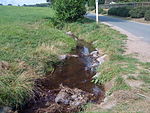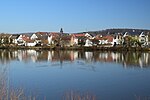DCF77 is a German longwave time signal and standard-frequency radio station. It started service as a standard-frequency station on 1 January 1959. In June 1973 date and time information was added. Its primary and backup transmitter are located at 50°0′56″N 9°00′39″E in Mainflingen, about 25 km south-east of Frankfurt am Main, Germany. The transmitter generates a nominal power of 50 kW, of which about 30 to 35 kW can be radiated via a T-antenna.
DCF77 is controlled by the Physikalisch-Technische Bundesanstalt (PTB), Germany's national physics laboratory and transmits in continuous operation (24 hours). It is operated by Media Broadcast GmbH (previously a subsidiary of Deutsche Telekom AG), on behalf of the PTB. With Media Broadcast GmbH, a temporal transmission availability of at least 99.7% per year or under 26.28 hours of annual downtime has been agreed upon. Most service interruptions are short-term disconnections of under two minutes. Longer lasting transmission service interruptions are generally caused by strong winds, freezing rain or snow-induced T-antenna movement. This manifests itself in electrical detuning of the antenna resonance circuit and hence a measurable phase modulation of the received signal. When the maladjustment is too large, the transmitter is taken out of service temporarily. In the year 2002, almost 99.95% availability, or just over 4.38 hours of downtime, was realized. The timestamp sent is either in Coordinated Universal Time (UTC)+1 or UTC+2 depending on daylight saving time.The highly accurate 77.5 kHz (3868.2897806 m wavelength) carrier signal is generated from local atomic clocks that are linked with the German master clocks at the PTB in Braunschweig. The DCF77 time signal is used for the dissemination of the German national legal time to the public.Radio clocks and watches have been very popular in Europe since the late 1980s and, in mainland Europe, most of them use the DCF77 signal to set their time automatically. The DCF77 longwave radio emission offers penetration into buildings and the time-transmissions can be received by small ferrite antennas incorporated in the case of radio-controlled low-cost time keepers without the help of exterior antennas. The accuracy of the DCF77 amplitude-modulated time signals suffices for the every-day use of clocks and watches by consumers where primarily the long-term accuracy matters. Further industrial time-keeping systems at railway stations, in the field of telecommunication and information technology, and at radio and TV stations are radio-controlled by DCF77 as well as tariff change-over clocks of energy supply companies and clocks in traffic-light facilities.










